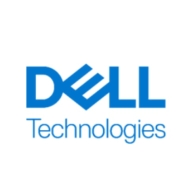


Hitachi Virtual Storage Platform and Dell PowerStore are leading storage solutions in the IT industry. Hitachi appears to have the upper hand in performance and scalability, while Dell is noted for its integration and support capabilities.
Features: Users value Hitachi Virtual Storage Platform for high performance, efficient scalability, and robust performance suitable for heavy workloads. Dell PowerStore is recognized for its flexibility, excellent integration capabilities, and adaptability to various IT environments.
Room for Improvement: Hitachi users suggest improvements in provisioning, automation features, and user interface simplicity. Dell users point to software stability, advanced analytics, and optimization of update processes.
Ease of Deployment and Customer Service: Hitachi's deployment process is complex but aided by effective customer support. Dell PowerStore offers smoother deployment and easier integration. Both offer strong customer service, with Dell being more user-friendly in deployment.
Pricing and ROI: Hitachi Virtual Storage Platform involves significant upfront costs but offers a high ROI due to reliable performance. Dell PowerStore features competitive pricing and quicker ROI due to efficient resource utilization.
By opting for the gold subscription every three years, you get a free upgrade to the latest controller release.
If you wait more than seven years to buy another one, you get a return on your investment.
If you purchase storage with 300 terabytes, you can easily achieve one petabyte of effective capacity.
It's been trouble-free the entire time, with very high performance, as it has been designed and built properly.
We have seen a return on our investment in Dell PowerStore; definitely our cost per terabyte has been very good compared to some of the other vendors that we would have been using previously, and our performance benchmarks have exceeded what we were expecting.
While performance, security, and financial aspects of Hitachi Virtual Storage Platform are satisfactory, I am unsure about the exact return on investment.
We also had one outage where a controller of one of the products had failed and had to be replaced on-site.
Customers always have their issues resolved promptly.
Pure has good storage.
If necessary, they will search for a specialist within their Dell network who we can approach with our questions.
I would rate the technical support of Dell PowerStore between nine and ten out of ten.
They're responsive, knowledgeable, and have a quick turnaround.
The time taken to act upon issues is quite large, and issue identification takes a significant amount of time, especially when it comes to critical problems.
It is highly scalable.
It is suitable for both medium-sized and enterprise businesses.
It hasn't broken down anytime in the last six to seven years, despite hurricanes, earthquakes, and power outages.
The solution's scalability is a ten out of ten.
The customer likely exceeds 20,000 users globally.
You can create as many tools as needed, providing scalability based on the use case.
During the eight years, there have been no problems such as hardware failure or stopping.
I would rate the stability of the solution as a ten out of ten.
I would rate the stability of the product at seven out of ten.
When I removed all the cables, it failed over within five minutes.
There are no bugs or glitches and it doesn't crash or freeze.
I would rate the stability of Dell PowerStore as ten out of ten.
If we are running on a standalone infrastructure, I would rate Hitachi Virtual Storage Platform a 10 for stability.
We would appreciate a built-in transparent failover in the next release to eliminate the need for a separate metro cluster.
I'm eagerly anticipating the roadmap's promise of introducing multiple controllers, which could significantly boost scalability and resilience.
We mostly rely on long-term releases. We don't need the most up-to-date features, but we need a reliable environment.
If you want to delve into where your I/Os are going, the reporting might need more in-depth information to make informed decisions.
In my organization, we have had to go through two weeks with no replication, which is not very handy for our production environment.
Something needs to be done with the caching to ensure that if some issue occurs, there needs to be an ability to disable caching during maintenance to make it static, safe, and good.
The interface management and monitoring need improvement.
While the prices may be higher than those of other vendors, we see it as a market leader with benefits.
The support can be a bit pricey, but the solution is more cost-effective than anything else out there.
I would give it a nine out of ten in terms of costliness.
Likely the cost is $400,000 whereas IBM may be $250,000.
Based on my experience, the cost of Dell PowerStore for around 500 GB of capacity is very competitive compared to any other platform in the market.
There's no need to pay for a license; it's all-inclusive.
The cost of Hitachi Virtual Storage Platform is reasonable compared to competitors.
Pure Storage has signature security technology, which cannot be deleted, even if you are an administrator.
The platform's robust features include excellent sustainability tracking, and a comprehensive dashboard offering insights into IOPS, bandwidth, performance, and virtual activities.
Its data compression feature is the best that we have ever seen.
The solution promotes data reduction, often meeting the compression ratio.
The PowerStore's compression ratio is even higher than the Unity system.
The deduplication part of the solution is valuable since, as a user, you get more space for less money.
The active data management of Hitachi Virtual Storage Platform, especially with the HOPS Center, makes it easier to work with the Hitachi Virtual Storage Platform infrastructure.



| Company Size | Count |
|---|---|
| Small Business | 15 |
| Midsize Enterprise | 11 |
| Large Enterprise | 12 |
| Company Size | Count |
|---|---|
| Small Business | 41 |
| Midsize Enterprise | 27 |
| Large Enterprise | 61 |
| Company Size | Count |
|---|---|
| Small Business | 19 |
| Midsize Enterprise | 14 |
| Large Enterprise | 28 |
Pure Storage FlashArray//X is the world’s first enterprise-class, all-NVMe flash storage array. It represents a new class of storage – shared accelerated storage, which is a term coined by Gartner – that delivers major breakthroughs in performance, simplicity, and consolidation.
Dell PowerStore is a scalable, high-performance platform supporting both modern and traditional workloads, enhancing IT operations with AI-driven automation and advanced data reduction features.
Designed for flexibility, Dell PowerStore integrates seamlessly with VMware, providing robust security and high IOPS. Users benefit from fast NVMe storage, intelligent data management, and scalable performance to handle diverse workload demands. However, improvements are needed in replication, enterprise functionalities, and UI complexity. Stability and support issues highlight the need for enhanced monitoring and pricing strategies.
What are the key features of Dell PowerStore?In industries like finance, healthcare, and IT, Dell PowerStore is critical for VMware virtualization, high-performance databases, and backup storage. It supports hosting virtual machines, mirroring storage, and handling SAP and Oracle databases effectively. Its role in hybrid and on-premises setups showcases its adaptability and integration capabilities for mission-critical tasks.
RETHINK YOUR DEFINITION OF SPEED AND PERFORMANCE
With adaptive, guaranteed data reduction and a 100% data-availability guarantee, Hitachi Virtual Storage Platform F series helps you tackle complicated business challenges. Hitachi Data Systems (HDS) VSP F series delivers up to 4.8M IOPS with sub-millisecond response times.
Featuring legendary Hitachi reliability, VSP F series arrays are backed by the industries only 100% availability guarantee. For these reasons, 80% of the Fortune 500 choose Hitachi all-flash arrays to accelerate the performance of mission-critical applications like Oracle, SAP, Virtualization, Microsoft apps etc. With over 350 patents in flash technology, Hitachi’s innovative mix of flash hardware and software accelerates ROI with enterprise-class reliability and performance.
We monitor all NAS reviews to prevent fraudulent reviews and keep review quality high. We do not post reviews by company employees or direct competitors. We validate each review for authenticity via cross-reference with LinkedIn, and personal follow-up with the reviewer when necessary.